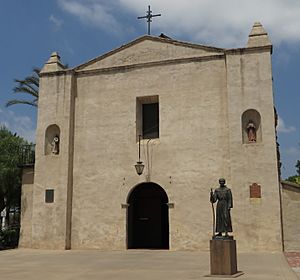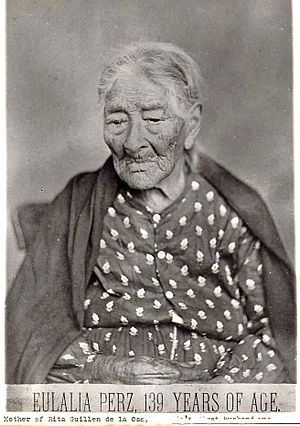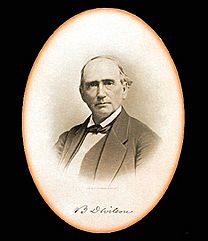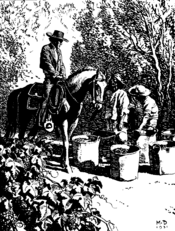Victoria Reid facts for kids
Victoria Reid (born around 1809 – died December 23, 1868) was an important woman from the Tongva village of Comicranga, which is now Santa Monica, California. She was special because she was one of the few Native American people who received land from the Mexican government. She was also highly respected in Mexican California. She married Hugo Reid and later inspired the famous book Ramona by Helen Hunt Jackson. When she was young, people called her Bartolomea Comicrabit. After her second marriage, she became known as Victoria. People often called her Doña Victoria as a sign of respect.
Contents
Her Life Story
Early Years

Bartolomea was born in Comicranga between 1808 and 1810. Her father was the chief of her village.
When she was six years old, she was taken from her parents to Mission San Gabriel. This was done to teach her about Christianity. She lived in a special dormitory that was guarded. These places were called monjeríos in Spanish. Young girls and single women stayed there. The idea was to keep them safe and help them get ready for Christian marriage.

Bartolomea received special attention from Eulalia Pérez de Guillén Mariné. Eulalia was in charge of the keys at the mission. She chose Bartolomea to be her assistant when Bartolomea was very young.
First Marriage
Bartolomea stayed at the mission until she was 13. At that age, the mission leaders chose a 41-year-old Native American man named Pablo Maria to be her husband. He was a vaquero, which means a cowboy, and worked for the mission. During the time of the Spanish missions, new converts were encouraged to marry other converts. This helped the mission leaders keep control over them and their children as workers.
Bartolomea and Pablo had four children: Felipe, Jose Delores, Maria Ygnacía, and Carlitos. Her first child, Felipe, was born in 1822 when she was only 15. The couple received two small plots of land called parajes near the mission. This showed that the mission leaders saw her as having adopted Spanish customs and the Christian faith. Pablo Maria died in 1836, and Bartolomea became a widow.
Marriage to Hugo Reid
After Pablo Maria passed away, Bartolomea gained control of her land. She also had the freedom to choose her next husband. This was because she was seen as having adopted Spanish ways and Christianity.
In September 1836, she married Hugo Reid. Hugo had arrived in California in 1832. He was from Scotland and was in the process of becoming a citizen of the Mexican Republic. He changed his name to Don Perfecto Hugo Reid as part of this process. When she married Hugo, Bartolomea became Victoria Reid. Hugo Reid's standing in Mexico improved greatly because he was married to Victoria. She was a respected Native American woman with connections at the mission. Hugo also adopted all four of Victoria's children. This showed how much he cared for her. Because she married Reid, Victoria and her children were no longer officially classified as indios, or Indigenous people.
In 1838, Victoria received a land grant called Huerta de Cuati. This was for her work at the mission. She got help from the influential Eulalia Pérez de Guillén Mariné. The grant was about 128.6 acres (0.52 km2) and was about 2 miles (3.2 km) northeast of the mission. This was special because it was "one of the few Mexican grants given to an Indigenous person in southern California." The land was given only in her name. Hugo Reid was still becoming a Mexican citizen at this time.
By 1839, Hugo had completed his citizenship. The family then built the Hugo Reid Adobe. This adobe building still stands today, though it has been changed over time. In the 1840s, Victoria managed the Huerta de Cuati land. Her husband managed the Rancho Santa Anita. With help from her son Felipe, Victoria made the gardens on her land much bigger. She grew 20,500 grapevines and 430 fruit and nut trees. She also managed the making of brown sugar cakes and aguardiente, a type of strong drink. Her land used Native American workers, and aguardiente was often given as payment.
On August 18, 1843, her son Felipe married Maria de la Resureccion Ontiveros. Maria came from a family in Los Angeles who owned land. Her family had settled in the area with the first wave of Spanish settlers in California. This showed that Victoria's children were moving up in society in Mexican California.
In 1844, William Heath Davis visited the Reid home. He wrote that he was "surprised and delighted with the excellence and neatness of the housekeeping of the Indian wife [Victoria], which could not have been excelled." He also said the beds were "exquisitely neat, with coverlet of satin, the sheets and pillowcases trimmed with lace and highly ornamented." Davis usually had low opinions of Native American people. This shows that he saw Victoria as an exception to his usual views.
Changes in Society

After Alta California became part of the United States and then a state in 1848, Anglo-Americans became the main group in charge. Many new white settlers arrived. They brought different ideas about Victoria's marriage and her respected status as a Native American woman. White Americans often did not approve of marriages between different races. So, people were confused why a white man would marry a Native American woman. Her respected position also confused white Americans. They often linked Native American identity with poverty and bad behavior. In the Mexican period, Victoria's land and work helped Hugo Reid's social standing. But in the American period, Victoria's social standing depended on Hugo's protection and approval.
Victoria's daughter, Maria Ygnacía, was around 18 years old. White Americans often admired her beauty. However, they wrongly described her as "half-English, half-Indian." This was probably to make it easier for them to accept her beauty. It created a distance from admitting that a "full-blooded Indian" could be beautiful.
In 1851, Hugo Reid's health was failing. He published a series of articles in the Los Angeles Star called The Indians of Los Angeles County. Hugo hoped to become an Indian agent for the southern California area. He wanted the payment and to help the Native American people of the Los Angeles Basin, known as Gabrieleños (Tongva). Benjamin Davis Wilson thought Hugo was a very good choice. He said Hugo "perhaps exceeded those of any in the State" in knowing the Native Americans.
Around this time, Hugo secretly shared that he was becoming unhappy in his marriage with Victoria. This was likely because Victoria's status as a Native American woman was declining in the new white American society. This made his marriage seem like a problem for his own social standing. Hugo once copied a note that said, "Any man who would live with an Indian places himself on the level of brutes!" He called this note "Anecdote of a Lawyer" and kept it for some time.
Loss of Land
Hugo Reid died in 1852. This left Victoria as a Native American woman without the protection of being married to a white American in the new society. She quickly had a person appointed to manage her affairs, Benjamin Davis Wilson. She lost control of her property, which she had gained and greatly expanded during the Mexican era. In 1854, Wilson created a deed for the Huerta de Cuati. It claimed he paid Victoria about $8,000 for the property. However, her signature was only a cross symbol, even though Victoria could read and write. In 1855, a court appointed Agustin Olvera to manage Victoria's property. The court said this was "because the court considered her incompetent to arrange her own property."
End of Her Life
Before she died, Victoria made one last visit to Laura Everston King, whom she had met earlier. Victoria was described as wearing simple cotton clothes and wrapped in a quilt. She was attended by one Native American servant.
At the end of her life, Bartolomea lived at the San Gabriel Mission. She died on December 23, 1868, from smallpox. She was buried in the mission cemetery.
Her Legacy
Victoria Reid is remembered in history as one of the few Native American people who received land. This happened after the missions were taken over by the government by the First Mexican Republic. She achieved this with the support of Eulalia Pérez de Guillén Mariné.
Her marriage to Hugo Reid is a key part of Helen Hunt Jackson's book Ramona. This book tells a romantic story about the lives of people in California during that time. Jackson does not name Victoria in the book. She only calls her an "Indian squaw." This made Victoria's complex life seem much simpler and fit into a white American stereotype.



